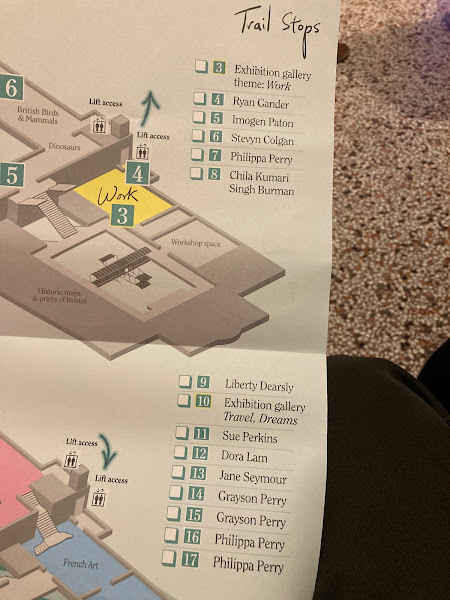Tuesday, 28 December 2021
Great Upcyclers #3: Stephanie Kilgast
Monday, 13 December 2021
Monsters attack Bristol!
A couple of evenings ago I drove down to the westcountry for the private view of Grayson's Art Club - The Exhibition Part 2 at Bristol Museum and Art Gallery.
I'm not going to write too much here; I'm just going to post some pictures from the night. It was wonderful to chat to Grayson and Philippa but also to people like Martin Parr, Anneka Rice, Johnny Vegas and many of the artists featured on the show. Rumour has it that Banksy was among the crowd but, as half of them were masked, who knows?
(His original stencil for his artwork at Reading Gaol - featured on Art Club Series 2 episode 2 - was on display and he has since stated that he will auction it off as an original artwork and put the money towards turning the old prison into an arts centre. isn't that great?)
(Incidentally - sorry about my unkempt beard. I was doing a photographer friend a favour by posing as Father Christmas for some shoots at the time!)And then there's the art itself - diverse, creative, brilliant. Enjoy!

 What a fantastic thing to have been part of. And they announced this evening that Art Club is back in March for a third series.
What a fantastic thing to have been part of. And they announced this evening that Art Club is back in March for a third series.Friday, 3 December 2021
Painting techniques #1 - Grime
Here's an absolute masterclass in miniature painting techniques by the team at Laser Creation World. They take a standard VW camper model kit and turn it into an epic post-apocalyptic shelter through extraordinary detailing and use of paint.
Watching these kinds of videos is how I've learned the techniques I use on my models. Learn from the best!
Saturday, 27 November 2021
Kitbashing
Saturday, 20 November 2021
Saturday, 13 November 2021
Greeblies, Greebles and Nurnies
Whatever you choose to call them, greeblies, greebles or nurnies are an essential for the serious scratchbuilder and trash-basher.
What are they?
They’re the hundreds of mechanical-looking parts that break up the surface of a model and give it the feeling of a real, working machine. According to Frank Burton, who was a department head on The Empire Strikes Back, 'Greeblie is a word George Lucas coined on Star Wars for something you can’t otherwise define.'
When you saw those huge star destroyers hove into view for the first time and marvelled at the surface detail, what you were actually looking at were thousands of pieces of rubbish and tiny parts cannibalised from model kits and stuck to the model's outer skin. Famously, the engine ports on Han Solo's Millennium Falcon are shovels from plastic bulldozer kits.
But, while Lucas might have given them a name, they predate Star Wars by at least a decade - certainly model-makers were using them in the late 1960s and early 70s on films like 2001: A Space Odyssey and TV shows like Thunderbirds. In fact, one of the industry's most infamous greeblies can be seen in the underground (or under swimming pool) hangar of Thunderbird 1.
Yes, that is quite clearly a lemon juicer/squeezer on the wall.































































